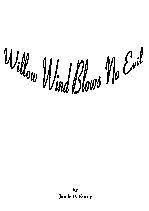


|
Willow Wind Blows No Evil.
Jamie D. Kucey.
Grades 10 and up / Ages 15 and up. *** /4
|

excerpt:
The smell of the water in the Oldman coming up on the west wind from the coulees, the smell of the water in the air to warn of upcoming rain. During sunshine and darkness, calm and storm, and all through the seasons of the year, the prairie had its own fragrance. Its beauty was sometimes hidden deep, but was always there - if not in the perfume of newly cut grass then in the stench of a prairie fire.
This title joins the growing body of non-British immigrant fiction which depicts being "foreign" as adding to the hardships endured by those who came to Canada in the early 1900s.
Willow Wind Blows No Evil tells the story of Eszter, who comes with her family from Hungary, determined to make a better life for herself . Her memories, dating from those of her eleven-year-old self up to the celebration of her one hundredth birthday, are interlaced with present-day events. The author manages to convey these complexities without using chronological order, which is an accomplishment in itself.
The protagonist appears hard and uncompromising to her parents, siblings and her own children, but this ability to appear impassive is the only way for her to survive the difficulties and disappointments of her life. She has a friendship stretching back to her early adolescence with Willow Wind Blows no Evil, a Blackfoot who suffers the many indignities bestowed by the dominant community upon his people.
The title, as explained on the back cover, "is a metaphor for how our pioneers survived the prairies. If one stands under a poplar tree and a willow tree during a windstorm, the difference in noise level is noticeable. The wind sounds much louder beneath the poplar. The poplar snaps its branches while the willow tree bends. The willow is a symbol for the pioneer, who flourished by bending or adapting to all challenges."
The true strength of Willow Wind Blows No Evil is the convincing characterization of Eszter. As well, the descriptions of the prairie in its seasonal manifestations are evocative and beautiful, particularly for the prairie-bred reader. The relationship between the title character and Eszter, however, is not convincing. Nonetheless, this novel is a welcome addition to Canada's body of immigrant fiction.
Recommended
Katheryn Broughton was born in the prairies and taught high school English and Library skills for nineteen years in North York, Ontario. She has edited a book of short stories (entitled Heartland) for senior students. These days she writes about old houses for the historical society newsletter (which she edits) in her home town, Thornhill, Ontario.

To comment on this title or this review, send mail to cm@umanitoba.ca.
Copyright © 1997 the Manitoba Library Association. Reproduction for personal use is permitted only if this copyright notice is maintained. Any other reproduction is prohibited without permission.
Published by
The Manitoba Library Association
ISSN 1201-9364
AUTHORS |
TITLES |
MEDIA REVIEWS |
BOOKSHELF
BACK ISSUES |
SEARCH |
HOME